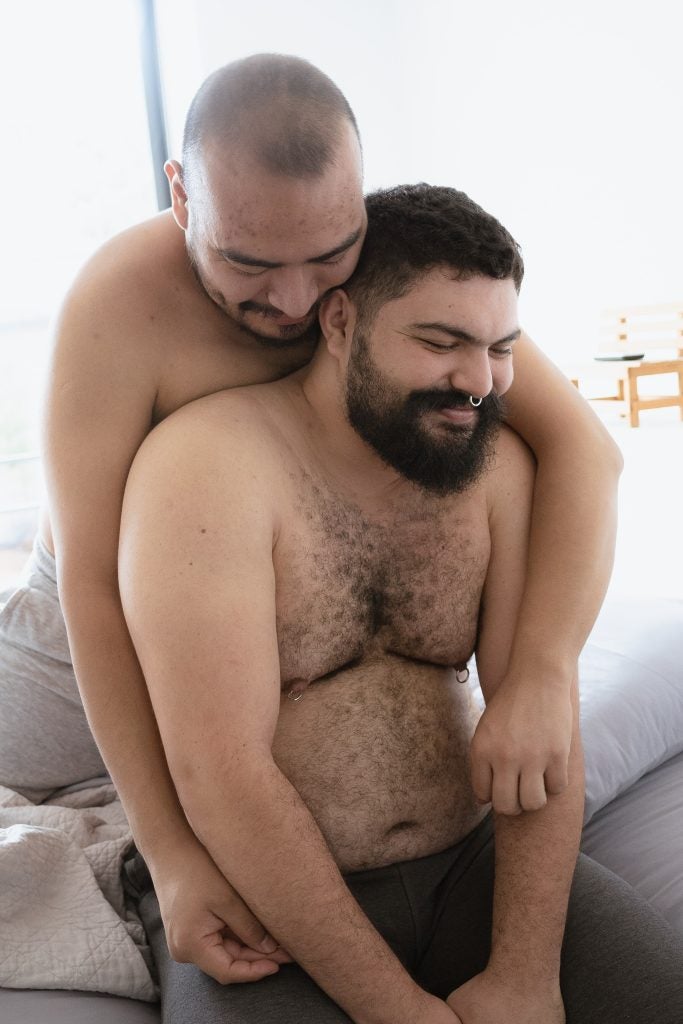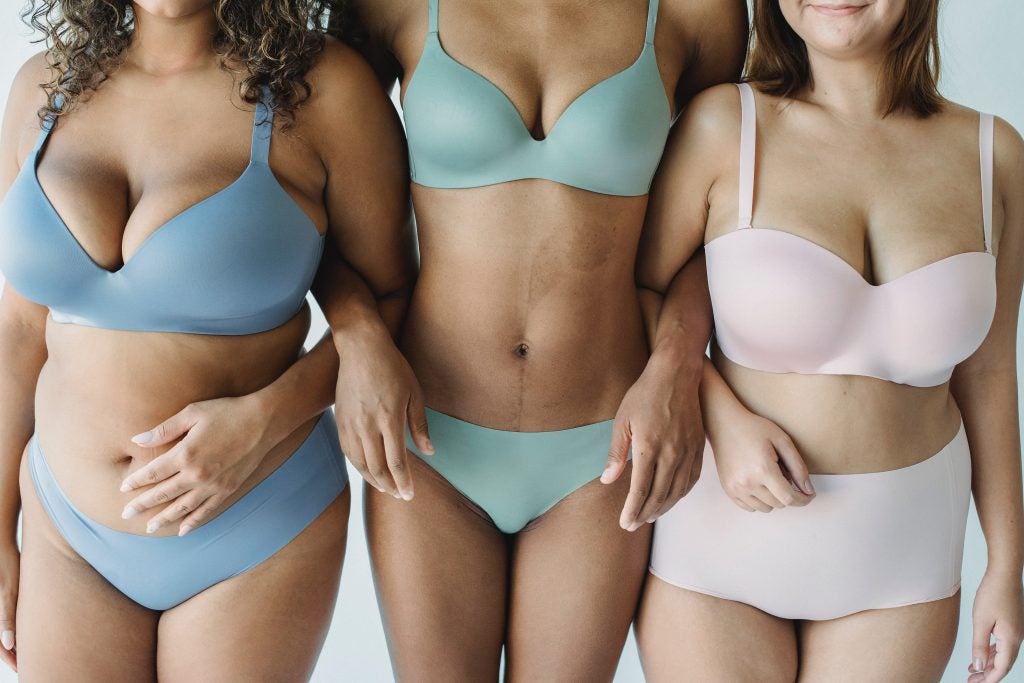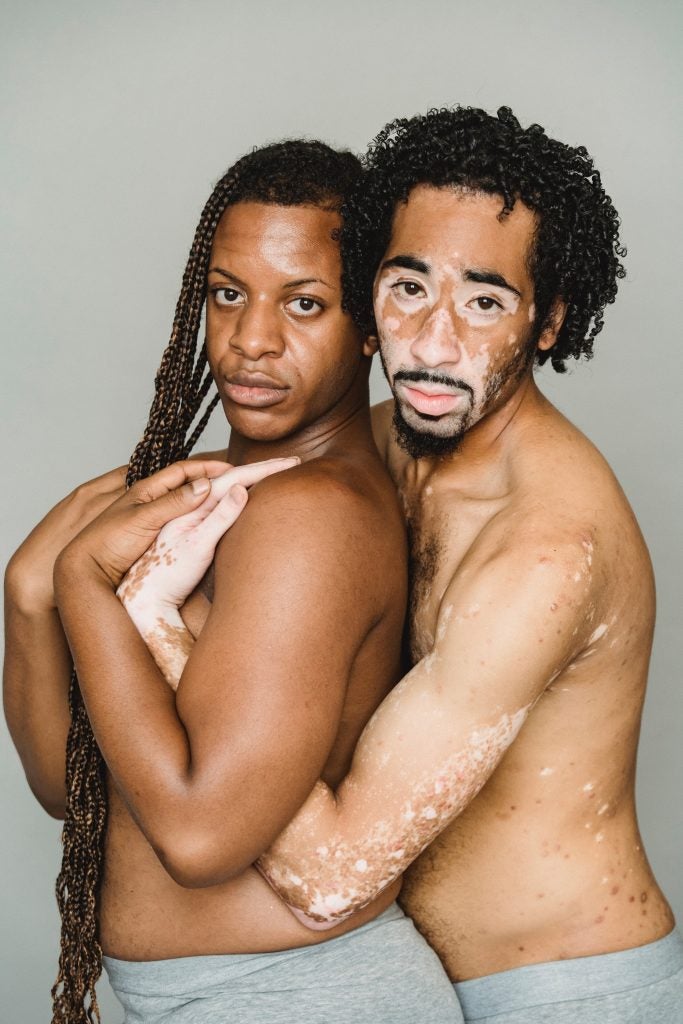
The term “body image” refers to the subjective mental picture you have of your physical appearance. This can pertain to small details about yourself such as your hair, weight, or complexion, or it could be regarding more intimate details such as your physique or genitalia—your external reproductive organs, usually male or female. Your thoughts about your body can either be positive or negative, but with the increasing presence of media in our society, many negatively compare their body image to those portrayed in the limelight. This is because the body types shown in the beauty and entertainment industries are often unrealistic and represent only a small proportion of body types. Many feel the pressure to conform to these “beautiful” body types. Females are generally portrayed as being tall and thin and having large breasts, and males are shown as having broad shoulders and “washboard” abs—body image ideals which are oftentimes unrealistic and unattainable.1 Regardless of how you look (or how you think you should look), your body image should not prevent you from having a healthy and satisfying sex life.
Table of Contents
Being Self-Conscious
Being unhappy with your own body is a challenging experience. Many people go through periods of time where they struggle with body-image issues, and these insecurities related to one’s body can sometimes feel inescapable. Body image can become especially personal in intimate settings. It can vary from feeling uncomfortable in sexual situations to avoiding sex altogether. In a recent study, researchers found that 52% of women have avoided or postponed sex, even when they were “in the mood,” because they were too self-conscious about the way their body looked.1 Being self-conscious can make sexual arousal difficult and can create challenges in the bedroom. For example, a woman who is extremely distracted by her appearance might not be able to become aroused enough to produce an adequate amount of lubrication for intercourse. Without an added lubricant, she may experience chafing and pain during coitus.2 Likewise, a self-conscious man may find it difficult to attain or maintain an erection if he feels displeased with his body. Becoming confident with one’s body can greatly benefit one’s sex life and intimacy with their partner.
If you do any of the following during sexual encounters, you are likely self-conscious of your body image:
- Turning off the lights to hide your body from your partner during sex.
- Speculating about your body image too much to enjoy sex.
- Only having sex in certain positons to hide particular body parts.
- Feeling like you need to diet and exercise to better enjoy your sex life.
- Believing your body is not good enough for your partner to enjoy.
If you have engaged in any of these behaviors, know that many others feel the same way and that you can learn to stop worrying about your body and become more body positive, thereby benefiting your sex life.
Examples of Body Image Issues

Negative body image can hurt your sex life in several ways.One example of a behavior that results from poor body image is spetatoring. This can decrease arousal, pleasure, and lubrication.4 Women often focus on their breast size, vaginal appearance, and body shape during sex. Males often worry about their penis size and muscular build. The internal monologue in peoples’ minds can cause sex to be a source of extreme anxiety.
Female Body Image Issues
Female body image issues are largely driven by how women’s bodies are portrayed in the media, generally showing only one “ideal” body type that is considered “sexy” or “beautiful,” unrepresentative of a majority of the world’s women.5 In America, the ideal female body usually has large breasts and buttocks, with a small waist. Filipino culture values fatness because it is a symbol of wealth and strength. Cultural preferences play a huge role in defining the “ideal” body type.6 While one culture may find thin bodies to be the ideal, another may find this unattractive. Beauty is entirely subjective, so there is no real way to define an attractive or unattractive body. This is important to remember when learning to love your body; there is no one body or body type that is beautiful.
Women usually worry about their breasts, buttocks, waist, and labia majora/minora shape and sizes. Women even worry about the “tightness” of their vagina. Females with large breasts and butts and a smaller waist have an hourglass body shape that is most commonly shown in Western media. This body type is considered womanly and sexy, causing women with different body types to feel inadequate.1 Labia majora, labia minora, and vaginal opening (introitus) sizes are often tied to sexual promiscuity. A common misconception is that a woman with labia majora extending past her labia minora or a less tight vagina has had a lot of sex. Women often worry about the appearance of the parts of the vulva due to this misconception or simply because they think their labia are unattractive after comparing themselves to those portrayed in porn, which often do not represent the wide variety of female bodies. However, labia majora and minora are shaped differently in all women and labia majora do not grow longer when a woman has had more sex.7 The vaginal walls are elastic and will expand during arousal, causing the vagina to feel “looser.” Once arousal decreases, the walls will tighten again. Essentially, vaginal tightness is not a good indication of promiscuity and simply indicate the level of arousal the female is experiencing.8
Male Body Image Issues
Though much less discussed, men are actually equally dissatisfied with their body image as females.9 One reason male body image is less discussed is because it is assumed that men experience similar body images to women.9 However, male body image is more complex than people generally believe and concerns more than just muscles. Since male body image is less discussed, men will usually not discuss their issues as openly, internalizing their insecurities.
Men often concern themselves with penis size as a form of body insecurity. They believe that a larger penis size gives partners more pleasure, and thus a smaller penis makes them feel less masculine and inadequate. However, a study published in the BMC Women’s Health Journal, 50 sexually active females who had has two or more partners were interviewed about their sexual preferences. Almost all females reported that penis length did not make any difference in sexual pleasure.10 In Western culture, having “washboard” ab muscles, a skinny waist, broad shoulders, and large muscles is seen as the ideal male body. However, similar to the ideal female body, this is unrepresentative to most male bodies. Those who do not fit this unrealistic standard feel less masculine and may have troubles with arousal during sex.
Post-Operation
Operations are another source of body image concerns due to the physical changes which occur. Operations can cause scars or other bodily changes which take time to adjust to, during which one can feel uncomfortable in their skin. Surgeries that treat areas such as the breasts, testicles, and the face can especially affect body image.11 However, changes to any part of the body can cause body image troubles. These body parts are what many people use to identify their gender, so that when those body parts are altered, these people feel less masculine or feminine, and therefore less sexy.
Pregnancy is another source of negative body image for females since it can result in weight gain, stretch marks, and altered genital appearance such as misshapen labia. Childbirth can result in the tearing of the perineum, the skin between the vagina and anus. An episiotomy, a surgical procedure which cuts the perineum to ease the tearing of that skin may also be performed. Episiotomies are on the decline since those who have undergone the procedure have found no direct advantage and have a more negative body image post-partum than those who did not undergo the surgery.12 Overcoming these major changes takes time depending on the individual’s health and difficulty of operation. It is important to remember that this “new” body is also now a healthier body, or one which has brought a child into this world. Operations take a toll on bodies and so time must be taken to allow the body to heal.
Being Intersex or Transgender
People who do not fall into the male or female categories can also experience negative body image. This people must combat the typical negative body image issues males and females experience, along with the added social pressure of not fitting into either of these categories. Some examples include intersex and transgender people. An intersex person is one whose reproductive anatomy does not fit the typical definition of male or female.13 A transgender is a person who does not identify with the gender they were assigned at birth. They may undergo reconstructive surgery or hormone therapy to alter their genitals to appear like the gender to which they personally feel they belong.14 Individuals who fall into this category must understand that their bodies are completely healthy and beautiful. These people’s anatomy does not define them and it should not alienate them. Learning that you are more than your body is a huge step to begin learning how to love yourself.
Communication
Anyone, regardless of sexuality or sex, is prone to negative body image, perpetuated by the media. If you are in a relationship try talking to your partner about your insecurities. Chances are your partner understands your insecurities because they have some, too. Talking about your body image anxieties openly with your partner will help you develop a more honest relationship that will lead to intimacy and better sex. By honestly and openly discussing any challenges you have, you can both overcome these body image issues together. Tell your partner what you love about them and their body; something you love about them could be a source of their insecurity and by reassuring them, you can help them overcome this insecurity. The process of becoming body positive is not a short one. There is no time constraint on when someone will truly learn to embrace their body: it could take someone a matter of months or years, but do not become discouraged if it takes you longer.
Body Positivity

Body positivity is learning how to be comfortable and confident in your body. It is not always a short or easy process, and it never occurs all at once. Some people take months to years to learn to love their body and some people learn to love their bodies more than once in different ways. While learning to become body positive, focus on the parts of yourself that you love rather than the parts which bring you insecurities.
In the Media
There are several companies attempting to project more realistic body images, especially of women since they are typically under more pressure to meet unrealistic standards. Companies like Dove Beauty and Aerie are showcasing women with a range of body types and using less photoshop.15 Plus-size models can now be found not only on websites but also on the runway. These public displays which show women of many shapes and sizes illustrate not only to women, but to the general public that the “ideal single body type” standards are very unrealistic. By seeing more people confident with their body image and the media portraying many different women with varying body types as beautiful, women can become more confident with their body type.
In Your Life
There are steps you can take to improve your body image in your life. Starting small can help reduce the sometimes overwhelming process into something manageable:
- Remind yourself that the media sets unrealistic expectations.
- Write notes to remind yourself that your image does not define you.
- Write down everything you love about your appearance and spend the day focusing on those parts of yourself.
- Exercise several times a week if possible, do not over-exercise as this can lead to discouragement and tiring out easily. Exercise can lead to better weight management, improved blood pressure, and an increased stamina.16
- Try to avoid focusing on your weight, and instead focus on building a healthy life and body.
- Remember that sex with someone else is a very personal experience: if you feel good about yourself, you will enjoy sex to its fullest potential. We often get caught up in trivial matters like appearance, but we must focus on sex as a source of mutual pleasure and connection, accessed with trust and respect.
Beginning to love the smaller parts of yourself will help build your confidence overtime. Working on this with a partner can help the both of you and better your sex lives.
Throughout Your Life
Puberty
The body goes through the most changes during puberty. Within the span of a few years, pubic hair and breasts start to grow, and penises and testicles can become larger. Your reproductive will begin to grow, whether those are your breasts, penis, or testicles. This can be an uncomfortable time because so much of your body is changing in a short span of time.17 If you are going through puberty, remember that as you go through this process, so are your peers. Your parents or any older friends have also gone through this process and can give you tips on how to become comfortable in your growing body. This is a time when you can begin to learn more about yourself and experiment with understanding your sexuality.
Adulthood
Adulthood is a time when your body undergoes more gradual changes. Some adults feel confident with these changing bodies, while others continue to struggle with finding body positivity, especially as they age. If you find yourself in your adult years struggling with your body image, take this time to communicate with your partner and continue to grow more comfortable with your own body. This process is not short, but the longer you continue to work on becoming comfortable with your body and learning what you like, the more confident and body positive you can become!
Senior Years
After adulthood, your body will undergo changes. Breasts become less perky, quality of erection and lubrication also usually decline.18 However, this does not mean your sex life is over. Many elderly people enjoy a fun and positive sex life as they age.19 Look on this time in your life as a positive turning point for your sex life. After years of knowing your body and experimenting with it, you may know what you like and do not like better than you ever have. Regardless of who you are with in your elderly years, whether it’s someone you have known for years or a new partner, you can effectively communicate your desires.
Concluding Remarks

Learning how to love your body is a very personal and long-term process. So often, the media portrays only one body type as beautiful, which many cannot attain. Constant exposure to these messages can lead to negative body image, but it is very possible to overcome! Begin by finding parts of yourself that you love. If you have trouble with this, ask a friend or partner, or loved one. Communicating concerns with a partner can not only help you alleviate insecurities, but can help the both of you to feel more confident in your own bodies, and greatly benefit your sex lives.
References
- Woertman, Liesbeth, and Femke Van Den Brink. “Body Image and Female Sexual Functioning and Behavior: A Review.” Journal of Sex Research, vol. 49, no. 2-3, 2012, pp. 184–211.
- “Vaginal Dryness.” Womens-Health-Concern.org. British Menopause Society. Aug. 2017. Web.
- Fallon, April E.,Rozin, Paul. (1995) Sex differences in perceptions of desirable body shape. Journal of Abnormal Psychology. Vol 94, No 1.
- Monroe, Val. (2001) Are Your Insecurities Ruining Your Sex Life? Oprah.com.
- Byrd-Bredbenner, C., & Murray, J. (2003). A comparison of the anthropometric measurements of idealized female body images in media directed to men, women, and mixed gender audiences. Topics in Clinical Nutrition, 18, 117–129.
- Townsend, Claire, Julie Y. Takishima- Lacasa, Janet D Latner, Andrew Grandinetti, and Joseph Keawe‘aimoku Kaholokula. (2014). Ethnic and Gender Differences in Ideal Body Size and Related Attitudes among Asians, Native Hawaiians, and Whites. Hawaii Journal of Medicine and Public Health. Vol. 73, No. 8.
- “What Is the Function of the Labium Minora?” Reference. N.p., n.d. Web. 28 Feb. 2017.
- Castleman, Michael. (2011). The Rare Truth About “Tight” and “Loose” Women. Psychology Today. Online.
- “Male vs. Female Body Image.” Bradley University.
- Eisenman, Russel. (2001). Penis Size: Survey of female perceptions of sexual satisfaction. BMC Women’s Health. Vol. 1, No. 3
- “Body Image and Sexuality.” Target Ovarian Cancer.
- Umich. “For Many Women, Body Image and Sex Life May Suffer after Episiotomy.” EurekAlert!, 25 Apr. 2017.
- “Intersexuality & Body Image.” Bradley University.
- “Transsexuality & Body Image.” Bradley University.
- “Dove Self-Esteem Project.” Dove US, 11 Jan. 2016.
- Simon, Ross M, et al. “The Association of Exercise with Both Erectile and Sexual Function in Black and White Men.” The Journal of Sexual Medicine, 20 Mar. 2015.
- “Puberty In Girls and Boys | What Happens During Puberty?” Planned Parenthood. Planned Parenthood Federation of America Inc., 2014. Web. 2 February 2016.
- Kalra, Gurvinder, Alka Subramanyam, and Charles Pinto. “Sexuality: Desire, Activity and Intimacy in the Elderly.” Indian Journal of Psychiatry. Medknow Publications & Media Pvt Ltd, 2011.
- Rao, Dr. Sathyanarayana, Dr. Abhinav Tandon, and Dr. Keya Das. “Sexual Myths and Misconceptions.” Erotic Memoirs and Postfeminis011): 83-90. TotalSexSolutions.com. Department of Psychiatry, JSS Medical College and Hospital. Web.
Last Updated: 2 May 2018.
